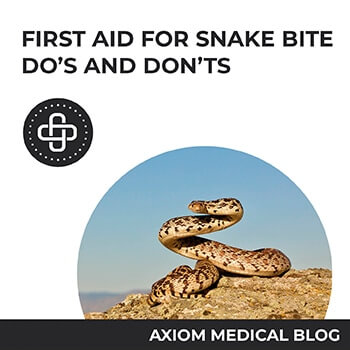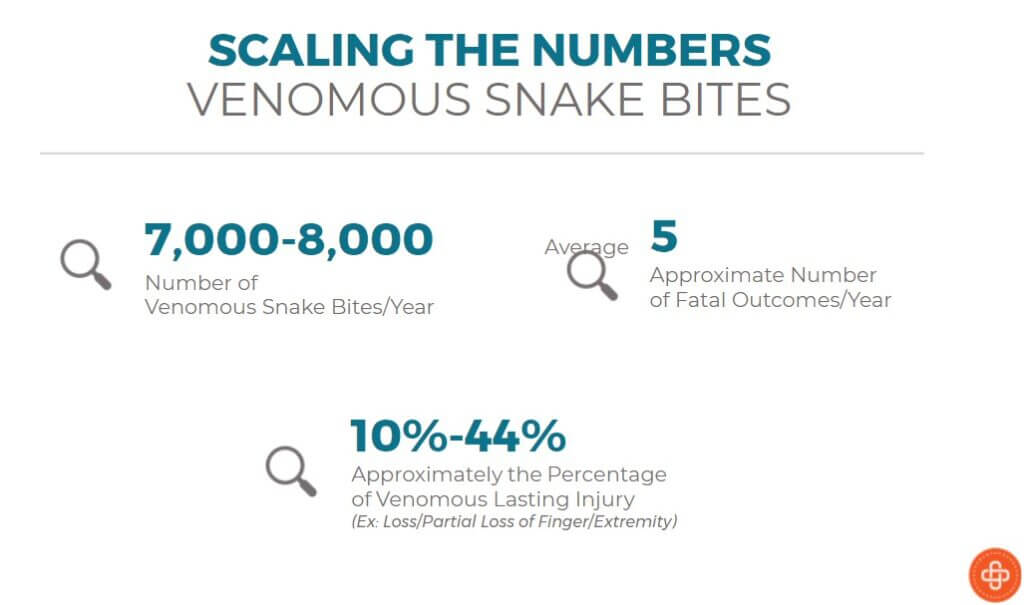In North America, 20% of the snake population is venomous. A snake bite by a venomous species may lead to severe injury and sometimes, even death. Apart from learning and understanding more about rattlesnake, coral snake, water moccasin, and copperhead, you should be aware of first aid for snakebite do’s and don’ts. Here are some frequently asked questions and first aid measures.

What Should I Do After A Snakebite?
If you are bit by a venomous snake, call 911 or contact your local emergency number immediately. Look for signs such as pain or swelling at the site of snakebite and a color change. In such situations, you must visit emergency rooms and may have to take anti-venom shots immediately.
What is the first aid treatment for a snake bite?
First-Aid:
Stay calm and call 911:
Even if a non-venomous snake bites you, you will need to get checked by a physician. When bitten by a snake, stay calm and lie in a semi-reclined position while keeping the bite wound below the level of the heart. This will prevent the venom from spreading to other parts of the body. Call 911 for emergency medical help.
Clean the wound:
If the bite site is bleeding, gently clean the area with soap and water. If possible, dress up the wound. Do not clean the area under running water.
Get medical help early
Venomous snake bite can be fatal. Therefore, get medical help as early as possible. The severe symptoms may only appear after several hours. Since snake bites can potentially be fatal, always treat this as a medical emergency. Call for immediate medical help early.

Symptoms
Snakebite wounds and symptoms may differ based on the amount of venom inside your body. Most snake bites occur on the extremities.
Typical symptoms are:
- Pain, itch, and scratch at the site
- Severe burning pain at the site within 15 to 30-minutes
- Swelling and bruising
- Change in color at the site
- Nausea, labored breathing, and weakness
- Odd taste in the mouth
- Skin tingling
- Difficulty speaking and lightheaded
Sometimes, a venomous snake can also bite without injecting venom. These dry bites only irritate the site.
Do and don’ts when a snake bites?
Do’s:
- If possible, take these first-aid steps while waiting for medical help:
- Not all snakes are venomous. That’s why the victim must remain still and calm if bitten by a snake. It will help slow down the spread of the venom.
- Remove jewelry, shoe, or any tight clothing before the snakebite wound starts to swell.
- It is advised to position yourself to keep the snakebite area at or below the level of your heart.
- If possible, keep the wound clean and wash it with soap and water. While not necessary, you may cover it with a sterile, dry dressing.
Don’ts:
- On the snakebite area, do not use a tourniquet or apply ice.
- Never puncture or cut the wound area in an attempt to release the venom.
- Avoid drinking any sort of caffeine or alcohol. This worsens the situation by speeding the venom absorption inside your body.
- Don’t harm or try to capture the snake. You may use your smartphone to take a picture of the snake from a safe distance for identification.
Watch our Axiom Medical’s Health Experts discussing this topic. Click below!
Snake Bitten!
Axiom Medical is Here To Help!
Does your organization need assistance with Workplace Contagious Illness Management and occupational health services? Axiom Medical can help. With two decades of experience in employee total health program and population health management, we can help your organization with any workplace healthcare needs. Contact us today to learn more!
Contact Us

With a career focused on digital marketing, Chitra is a specialized SEO-Content marketer. After moving from biotechnology to business operations and marketing, Chitra started her digital marketing career as a freelance content developer and technical writer. With Axiom, as a content marketing & SEO specialist, she is passionate about creating informative marketing copies for optimum search engine performance.
Find out more about our Tempo Live Behavioral Health and Injury Case Management services.










